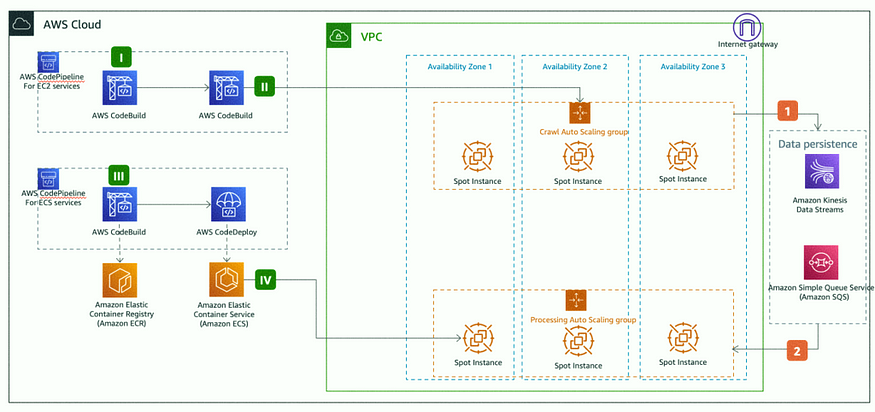Getting Started with Amazon EC2: Launch Your First Virtual Server in the Cloud

What is AWS EC2 sevice?
A web service called Amazon Elastic Computation Cloud (Amazon EC2) offers scalable compute capability in the cloud. For developers, it is intended to make web-scale cloud computing simpler. You can start virtual machines (VMs), sometimes called instances, with a range of operating systems and configurations using Amazon EC2. You can launch as many or as few virtual servers as you need, set up networking and security settings, and control storage using EC2. You may scale your resources up or down on EC2 to suit the demands of your application and only pay for what you use. This makes it a popular option for a variety of applications, from straightforward websites to sophisticated, data-intensive programs.
in the story version:
A business wants to reach more people online and increase their internet visibility. Though building and operating actual servers was expensive, time-consuming, and difficult, they realized they needed to construct more servers to manage the rising traffic.
At that point, they learned about the web service Amazon Elastic Compute Cloud (EC2), which enables them to quickly launch virtual servers, also known as instances, in the cloud. The organization was able to immediately launch as many servers as they required, in a matter of minutes, thanks to EC2. They could select the ideal setup for their particular application from a multitude of configurations and operating systems.
The business could quickly scale up or down the number of servers using EC2 in accordance with their traffic, so they only paid for what they needed. The nicest aspect was that EC2 took care of all the complicated networking and security issues, so they could concentrate on creating and running their application.
The business was able to handle the growing demand for their website and accomplish their aim of growing their online presence because to EC2. They continued to prosper and serve their clients effectively as they lived happily ever after.
How AWS EC2 works ?
It’s like having your own personal cloud genie with AWS EC2, or Amazon Elastic Compute Cloud. It’s a service that enables you to build up “virtual servers” that you can use and manage just like real, physical servers, but without the effort of actually configuring and maintaining physical hardware.
Imagine yourself building and configuring various “blocks” (virtual servers) as you wish, then connecting them to form a full system. It’s like playing with virtual Legos. Additionally, you can always disassemble and reassemble them, exactly as with Legos.
Here’s how it works in a nutshell:
You can select the size, memory, and processing power of the virtual server (often referred to as a “instance”), as well as its configuration.
You decide which software and operating system you want to instal on your server.
As if it were a real, physical server located in a data centre, AWS configures your virtual server and grants you access to it.
Afterward, you may access, customise, and utilise your server just like you would a real one, but AWS will handle all of the underlying hardware and upkeep.
The best aspect is that, in contrast to managing physical servers, you only pay for the resources and time that you really utilise.
Overall, EC2 makes it easy to create your own virtual servers and to be flexible with your scaling and resources as needed.
AWS EC2 architecture :
Scalable, on-demand computing resources are made available to customers through the AWS EC2 (Amazon Elastic Compute Cloud) architecture. The architecture comprises the following elements:
Regions and Availability Zones: Multiple geographic regions with numerous availability zones make up AWS (AZs). Each region has numerous AZs, which are isolated areas within a region that are designed to be highly available and fault-tolerant. A region is a geographical location (such as US East (N. Virginia)). Customers can do this to launch resources in different places for redundancy and to lessen the effect of outages.
Virtual Private Clouds (VPCs): Your EC2 instances and other resources can be launched in a VPC, which is a virtual network. Among other things, you can set up security groups, build subnets, and give your instances IP addresses. Your instances can run in a private, secure environment thanks to VPCs.
EC2 instances: The virtual servers that can be started in a VPC are as follows. There are various instance sizes and types available, each with varying CPU, memory, and storage capacities. A private IP address is given to EC2 instances when they are launched into subnets inside of a VPC.
Elastic Block Store (EBS): Block-level storage is provided via EBS for EC2 instances. You can retain data even after an instance has been terminated because it offers persistent storage for instances. To safeguard data from errors, EBS volumes are automatically replicated within their availability zone.
Elastic IP addresses: You can give them static, public IP addresses to your instances. By quickly remapping the address to another instance in your VPC, they enable you to hide the failure of a software or instance.
Auto Scaling: provides you with the option to automatically adjust the number of instances in an Elastic Compute Cloud (EC2) Auto Scaling group in response to variations in application demand.
Elastic Load Balancing : automatically spreads out incoming website traffic among numerous Amazon EC2 instances.
Together, these elements enable the provision of a scalable and adaptable computing environment for users. Customers may simply launch and manage virtual servers, set up networking and security settings, and store and retrieve data thanks to the EC2 service. All of this is accomplished by abstracting the complexity of the underlying hardware and maintenance, giving clients the ability to dynamically scale resources in accordance with demand and budget.

What are the benefits of AWS EC2?
Customers can gain from using AWS EC2 (Amazon Elastic Compute Cloud) in a number of ways.
Scalability: With EC2, you can quickly adjust the size of your computing resources to meet the demands of your application. Depending on your traffic, you can change the number of instances you’re running and only pay for what you actually utilise.
Flexibility: A broad variety of instance types, operating systems, and customizations are available using EC2. This enables you to choose the ideal solution for your particular application, whether it’s a straightforward website or a sophisticated, data-intensive programme.
Cost-Effectiveness: Using EC2 can be substantially less expensive than operating your own physical servers because you only pay for the resources and time that you really utilise. You can further cut the cost of running your instances by using services like Reserved instances, Spot instances, and Savings plans.
High availability: Your EC2 instances are redundant and high availability because they are deployed across different Availability Zones (AZs) in a region. This makes it possible to guarantee that your application is always accessible, even if one or more AZs experience an out
Security: To assist safeguard your instances and data, EC2 offers a number of security features, including security groups and network access control lists. In order to give your instances a secure environment, it also connects with other AWS services like Amazon Virtual Private Cloud (VPC) and AWS Identity and Access Management (IAM).
Elastic load balancing is a feature of EC2 that makes it simple to divide incoming traffic among several instances, enhancing the performance and availability of your application.
Auto Scaling: EC2 offers the capability of auto scaling, which dynamically modifies the number of instances in response to variations in demand for your application. This function helps to automatically scale resources based on actual consumption and save money on instances that are not required.
Integration with other AWS services: To offer a comprehensive, end-to-end solution for your application, EC2 instances may simply interface with other AWS services like Amazon S3, Amazon RDS, and Amazon DynamoDB.
Overall, EC2 offers users a safe and dependable infrastructure along with a flexible, scalable, and affordable way to execute their applications and meet their computing needs.

AWS instances Types:
Depending on the demands of your workload, you can select from a variety of EC2 instances:
On-Demand instances: With these instances, you can pay for compute capability on an hourly basis without making an advance purchase. For consumers who don’t want to make an upfront payment or commit to a lengthy contract but still want the affordability and flexibility of Amazon EC2, this is a suitable choice.
Reserved instances: These instances offer a sizable savings (up to 75%) compared to On-Demand instances, but a one-time upfront purchase and a one- or three-year term commitment are necessary. Users who have steady state or predictable consumption are best suited for this choice.
Spot instances: With these instances, you can place a bid for unused Amazon EC2 processing power. This is a wonderful choice for customers who can have unpredictable start and end times.
Dedicated Hosts: By enabling you to use your current server-bound software licencing, these instances let you operate your instances on a dedicated host, which can cut costs.
Dedicated instances are the ideal option for regulatory requirements that might not permit multi-tenant virtualization because they run on single-tenant hardware.
Burstable Performance Instances (T3) are an economical choice for workloads that do not demand continuous high CPU performance because they are made to balance compute, memory, and network resources.
Memory-optimized instances (R4, R5, etc.) are built for memory-intensive applications including high-performance databases, distributed memory caches, and in-memory data stores.
Accelerated Computing Instances (P3, P2, G3, etc.): These instances offer access to hardware-based compute accelerators, such as Graphics Processing Units (GPUs) and Field-Programmable Gate Arrays (FPGAs), to carry out computationally intensive operations.
The ARM architecture, which is different from the x86 used by the majority of EC2 instances, is used by instances of this type. Although ARM instances cost less than conventional x86 instances, they perform worse, are only offered in a limited number of locations, and have fewer AMIs that are readily available.
There is a lot of overlap in the use cases that each of these instance types can be applied to, but they all have different configurations and can be chosen based on your workloads and requirements. By choosing the proper instance type, you can drastically cut your costs while maintaining the performance of your workloads.
How to Launch Your First Virtual Server in the aws Cloud?
the precise procedures to start an “EC2 instance,” or virtual server, in the Amazon Web Services (AWS) cloud:
Visit the AWS website to register for an account.
Access the AWS Management Console by logging in.
Select “EC2” from the “Compute” menu’s drop-down list.
To begin launching a new virtual server, click the “Launch Instance” button.
The operating system and applications you wish to utilise on the virtual server should be represented by an Amazon Machine Image (AMI), so choose one of those.
Select an instance type that outlines your instance’s hardware specifications, such as the number of virtual CPUs and RAM.
Set the instance’s parameters, including its number of instances, IAM role, and network configuration
Boost your instance’s storage. At instance launch time, you can add storage volumes.
Set up security group to control inbound and outbound traffic for your instance as a virtual firewall.
Examine and start your instance.
Click launch after choosing or creating the key pair you’ll use to connect to your instance through SSH.
Once the instance has been started, you can connect to it through RDP or SSH and examine it on the EC2 instances page. From the EC2 instances page, you can also manage your instances, including stopping, starting, and terminating them.
Although the preceding procedure is a quick start to launch a basic instance in AWS, there are more settings and choices you may want to specify, such as setting up elastic IP addresses and auto scaling options.

For this technical blog, that is it. We appreciate you taking the time to read it, and we hope you found it instructive and beneficial.
